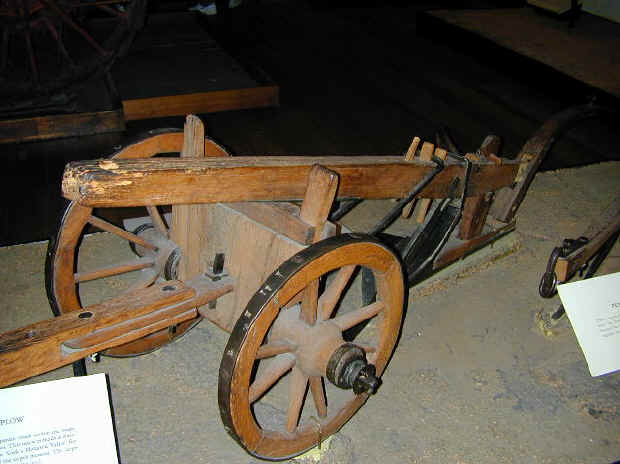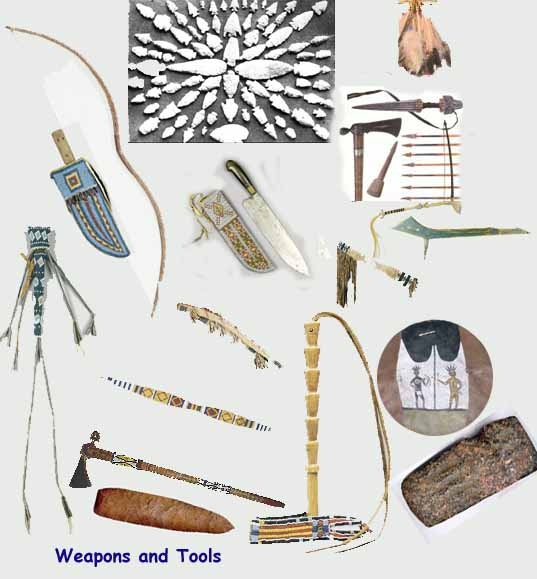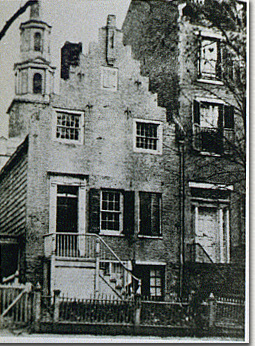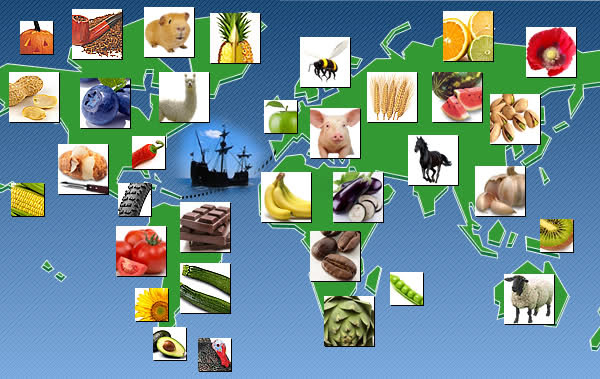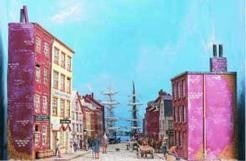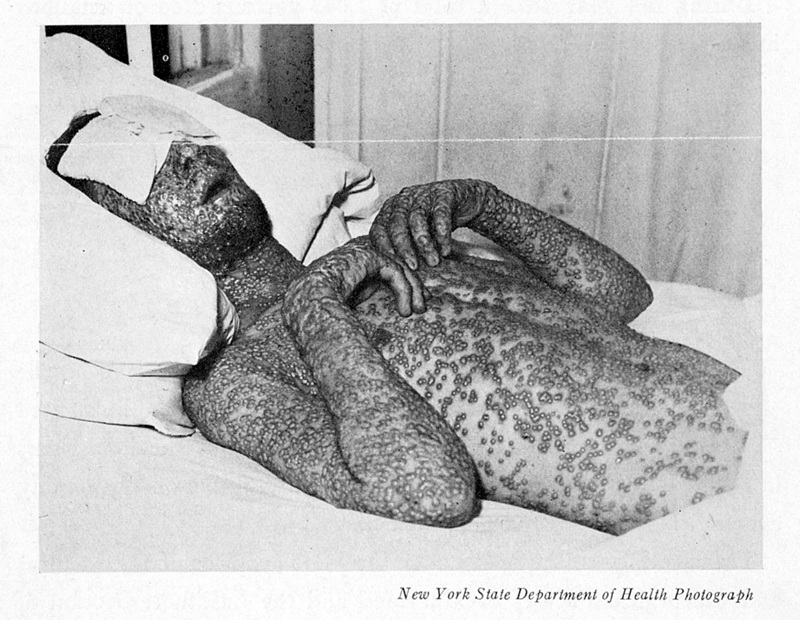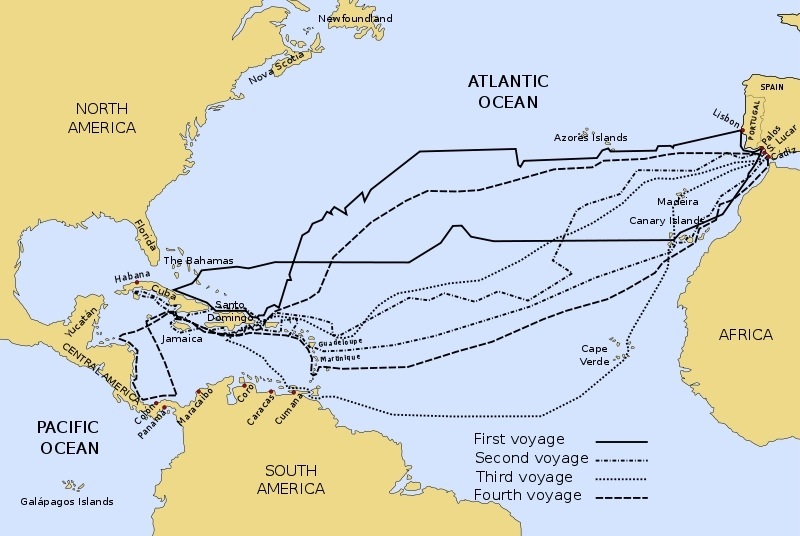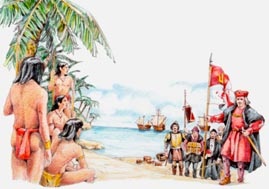New Farming equipment like the plow seen to the left ignited the New World economy and improved health on a long term basis. The plow was highly important because it cultivated large areas of land creating a surplus of plants for both Natives and Europeans. Animals such as horses and oxen would pull the plows across the land, this helped to cultivate more land. The vast farming land and rich soil were transformed into crop fields, which then lead to the establishment of towns. Because crops could be grown and the land could be cultivated, towns began to be established near farms. Natives created villages giving evidence of them moving away from the hunter-gatherer society. Europeans experienced greater crop output in the New World because of the rich soil that they did not have in Europe. The plow as seen to the left, was regarded as the main factor in the surge of agricultural output in Colonial America. This specific plow was taken from a Pennsylvania museum, we know that it was built in Europe because of the use of metal and its structure. This specific plow was used to cultivate lands by being pulled by horses and other large animals.
Guns and knives facilitated hunting and fishing for the Native Americans. While Natives already had knives, what they used were very malleable because they were made of obsidian and could not be used over and over like the European knives made of steel and iron. Before guns, spears, hatchets and bows and arrows were the most common used weapons of the Native Americans. A bow and arrow allowed for hunting from greater distances, but they did not do the same amount of damage as a gun. Some animals required more than one arrow to be killed. When Natives witnessed the destructiveness of guns they realized that they could use them for hunting larger animals. Natives now because of the migration of Europeans also had horses to ride. Natives could now chase down large herds of animals quicker and with the guns, they could kill them quicker. Weapons had such a profound impact on the Native American culture that they soon became the most widely traded goods between Europeans and Natives. Natives cherished weapons because of the hunter gatherer society they lived in. Europeans had an abundance of weapons and felt that parting with them for Indian goods such as labor or crops was worth the cost. Europeans used the natives fascination with firearms and weapons to exploit them. Europeans had such a comparative advantage in manufactured goods, that Natives became dependant on them for stronger weapons, thus allowing the Europeans to receive more for the goods.
European Architectural ingenuity helped to build new homes, ranches, farms, ports and ships in the new world. The establishment of these architectural structures lead to the establishment of the first colonial and native towns and also the first government buildings in the new world. Towns relocated Indians from their land into villages and towns. They also changed building patterns that used wood and charcoals which in turn led to more deforestation. Tools used for construction were made of steel and iron, this allowed natives to build stronger homes and it allowed for Europeans immigrants to build there homes to the same standard as back in Europe. The wheel played a major role in construction. Large heavy pieces of construction were able to be transported with greater ease with the wheel. The wheel was later used in ships as well. As more and more homes were built towns were established and with them sea ports as well. Europeans used their own ships to model those made in the New World. With the opening of ports and building of ships the New World, was opened to trade and in the near future, the West African Slave trade. The modern map also can attribute its creation to the establishment of ports along the coasts of the New World. Top left is a drawing of an early New York harbor, you can see two ships in the distance in between the buildings. Top right is a depiction of Boston harbor, this picture is supposed to represent the Harbor after the Boston Tea Party. Looking at the picture you can see the high traffic are that the harbor became, sailors merchants and immigrants traveled to Boston harbor in great numbers and it became a forefront for transatlantic trade and migration. Below is a picture of The Lendeert Bronck house in Coxsackie NY. This stone and brick building was built in 1670, but the remodeling into brick took place in 1738. This is just another example of European ingenuity.
The written alphabet is notable because of how it was used by the Europeans. Since Native Americans had no formal written language, Europeans knew that establishing relations by way of treaties would be difficult. Europeans educated Natives by teaching them to read and write a European language, this would help break down barriers, thus integrating cultures. At first the natives were skeptical about the written language, because Natives never followed a written agreement, blood oaths were their highest form of agreement. Europeans did not just try and teach them language for the purpose of trade. Europeans used their alphabet to "educate" Natives as well, by trying to convert them to Christianity. In a Social Darwinism sense, Europeans believed that Christians were above the barbaric Natives. They believed that unless natives accepted Jesus they would be damned, also a common religious belief among them, would bond them greater then any written code. Religion was a major technological advancement because Europeans believed they were educating and changing natives for the better. Europeans held Christianity to the highest standard in social importance, and considered conversion an evolution. To the left is a key of An early 17th late 16th century Dutch alphabet. Below is a syllabary of an original Cherokee language. This written syllabary is a key step in the technological movement and the intellectual growth of the Native Americans by way of the Columbus Exchange.
The passage from the Old World to the New World was not only made by humans, but by animals as well. The natives only had a few animal servants. They had the dog, two kinds of South American Camels, the guinea pig, and several kinds of fowls. On Columbus' second voyage, horses. dog. cattle. chicken, sheep, and goats. Explorers brought back turkeys, llamas, alpacas, and guinea pigs to Europe. These animals did not have as much of an impact on the Old World as the animals brought to the New World had.
The Columbian Exchange influenced technological advances in the late 15th and early 16th centuries. Europe was an economic and technological power compared to the Native Americans they encountered in the New World. Yet, they still benefited from the exchange of ideas and cultures. Native Americans were impacted profoundly by the technological transition. When Europeans crossed the Atlantic and colonized the New World they sparked a flow of changes in Native American culture.
The most notable of these changes were: A Written Alphabet New Farming Capabilities New Firearm and Weapon Capabilities Architectural Ingenuity Within just a few generations, the continents of the Americas were virtually emptied of their native inhabitants – some academics estimate that approximately 20 million people may have died in the years following the European invasion – up to 95% of the population of the Americas.
No medieval force, no matter how bloodthirsty, could have achieved such enormous levels of genocide. Instead, Europeans were aided by a deadly secret weapon they weren't even aware they were carrying: Smallpox. Smallpox is a viral infection which usually enters the body through the nose or throat. From here the virus travels to the lungs, where it multiplies and spreads to the lymphatic system. Within a few days, large pustules begin to appear all over the victim's skin. Starting with the hands and the face, and then spreading to cover the rest of the body, each blister is packed full of smallpox DNA. If punctured, these blisters become highly infectious, projecting fresh smallpox particles into the air and onto surrounding surfaces -such as someone else skin. It is a disease that requires close human contact to replicate and survive. With each epidemic eruption, some people survived, acquiring antibodies and immunities which they passed on to the next generation. Over time, the population of Europe gained increased immunity, and the devastating impact of traditional infections decreased. Yet the people of the New World had no history of prior exposure to these germs. They farmed only one large mammal – the llama – and even this was geographically isolated. The llama was never kept indoors, it wasn't milked and only occasionally eaten – so the people of the New World were not troubled by cross-species viral infection. When the Europeans arrived, carrying germs which thrived in dense, semi-urban populations, the indigenous people of the Americas were effectively doomed. They had never experienced smallpox, measles or flu before, and the viruses tore through the continent, killing an estimated 90% of Native Americans. Smallpox is believed to have arrived in the Americas in 1520 on a Spanish ship sailing from Cuba, carried by an infected African slave. As soon as the party landed in Mexico, the infection began its deadly voyage through the continent. Even before the arrival of Pizarro, smallpox had already devastated the Inca Empire, killing the Emperor Huayna Capac and unleashing a bitter civil war that distracted and weakened his successor, Atahuallpa. The Columbian Exchange is often times praised for the positive things that it brought about such as the exchange of new animals, foods, and plants between the Old World and the New World. However, not all of the aspects of the Columbian Exchange were positive. It is also important to realize that the Columbian Exchange can also be credited for the transmission of diseases which had adverse effects on both the Old and New World alike. Diseases were transferred from Europeans to Native Americans as well as vice versa. According to Alfred Crosby, " the migration of man and his maladies is the chief cause of epidemics. And when migration takes place, those creatures who have beer genetic material has been least tempered by the variety of world diseases" (Crosby 37). Europeans and Native Americans suffered immensely from disease that were foreign to them. Common Old World Diseases included:
With the large numbers of disease brought by the Europeans to the New World, the Indian population was immensely impacted by these illnesses. The Indian population was devastated by the illnesses brought by the European for several reasons:
Perhaps the most deadliest of diseases in regard to the Indians was smallpox. One of the first epidemics to arrive in America, smallpox was considered to be the deadliest. Smallpox is "occasionally misdiagnosed as influenza, pneumonia, measles, scarlet fever, syphils,or chicken pox" (Crosby 42). Misdiagnosis was an even more common problem four hundred years ago. Smallpox killed tens of thousands of Indians in the New World.
Indians, however, were not the only victims of disease. Syphilis, an Old World disease, had a severe effect on Europeans. Syphilis was a disease transmitted by sexual contact. It was common for sailors to contract the disease since they were without women for such long periods of time during the voyage to the New World. As Alfred Crosby puts it, " If we may assume that the nature of sailors in the sixteenth century was not radically different than in the twentieth, then we can imagine no group of the former century more perfectly suited for guaranteeing that venereal syphilis would have worldwide distribution".
The Colombian Exchange refers to a period of cultural and biological exchanges between the New and Old Worlds. Exchanges of plants, animals, diseases and technology transformed European and Native American ways of life. Beginning after Columbus' discovery in 1492 the exchange lasted throughout the years of expansion and discovery. The Colombian Exchange impacted the social and cultural makeup of both sides of the Atlantic. Advancements in agricultural production, evolution of warfare, increased mortality rates and education are a few examples of the effect of the Colombian Exchange on both Europeans and Native Americans. |
